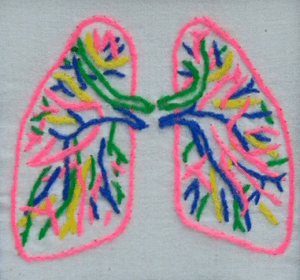Written by staff therapist Tammy Paine
Have You Taken A Full Breath Today?
Have you ever been mesmerized by the breathing of a sleeping child? Notice how their little tummies expand when they inhale and relax with exhalation.
Efficient breathing doesn’t come from the chest muscles. While our lives take on stresses, we tend to breathe higher and higher into these chest muscles. But an efficient and full breath actually comes from the diaphragm; a dome shaped muscle that sits just under your rib cage. When we take in a full inhale and recharge our cells with vital energy, the diaphragm contracts and flattens, descending quite a distance toward our feet. This causes the belly to expand as the lungs are filled with air. When we exhale, the diaphragm relaxes and air exits the lungs. In restful postures such as when at work at the desk or relaxing at home, this is the most effective way to breathe.
During restful and clam breathing, there should be minimal effort expended by the secondary neck and chest muscles. During exercise, these accessory muscles (parasternal, scalene, sternocleidomastoid, trapezius, and pectoralis major) kick in to assist respiration. But normal everyday breathing should not place this kind of stress on our neck and body as a whole.
Why is it that most of us have become shallow breathers during restful activities? Somewhere along the path of growing up, we forget how to breathe. How many times a day do we suck our belly in order to look skinnier? I remember the phrase “sit up, shoulders back, suck in your stomach” as a child. Not only does this goes against our natural way of breathing it puts extra stress on ouir muscles and our lungs receive LESS oxygen!
During your everyday breathing, do you find yourself breathing shallowly? Try the full, restful breathing, using your diaphragm, as described below and take advantage of your full lung potential.
Try this breathing exercise while sitting in your chair or at night when your mind won’t stop its constant chatter. The exercise is very simple and effective:
~Find a quiet place where you know you will not be disturbed.
~Lie down on a flat firm surface on your back, use pillows as needed for comfort and put one hand on your diaphragm (just bellow the belly button). (You can also do this in a sitting position with your eyes closed).
~Put one hand on your upper chest. You should feel no movement here. The breathing should come from your diaphragm and your other hand will gently rise and fall.
~Close your eyes and slowly breathe through your nose.
~Notice the feeling and how it differs from chest breathing.
~Consciously breathe through your nose, keeping your mouth closed. Feel the rising and falling of your diaphragm.
~Wait 3-4 seconds before beginning your next breath.
~When you become used to breathing into your diaphragm, bring your attention to the flow of your breath. Is it smooth or jerky? Smooth it out, make it flow gently and smoothly.
~Do not rush your breath. Be gentle. Let if flow and you will discover a rhythm to the breath.
*technique from www.stress-relief-tools.com
Feel your body relax with each breath. Notice that your shoulders fall away from your ears. With each exhalation your tissues feel lighter & less stressed. Your mind becomes more clear & less distracted.
As this gets easier lying down, eventually you can try it sitting while watching tv, at the computer, while driving your car. Make this your normal way of breathing & your sense of vitality will improve as you feed your muscles and cells with oxygen.
Read about Tammy Paine, massage therapist at Hands On Health. Thank you Tammy for writing this fabulous article!
Curious about breath matters? Learn more:
* http://www.rnceus.com/resp/
* http://www.stress-relief-
* http://www.
* http://psychology.uga.edu/sites/default/files/CVs/Clinic_Diaphragmatic_Breathing.pdf
= = = = =
Hands On Health Massage Therapy And Wellness
7980 Chapel Hill Road, Ste 125
Cary NC 27513
919.854.9555


